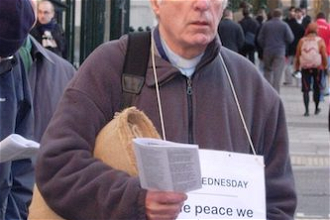Rome: Cardinals meet to discuss Holy See
In the Holy See Press Office today, Archbishop Piero Marini, master of the Liturgical Celebrations of the Supreme Pontiff, and Holy See Press Office Director Joaquin Navarro-Valls, held a press conference to provide some information on today's meeting of cardinals and on the period of the vacant See. Navarro-Valls explained that "the third general congregation held today was attended by 88 of the 91 cardinals present In Rome," and that those who participated considered themes "concerning the Pope's funeral and the upcoming conclave, the date of which has yet to be established." Later, replying to journalists' questions, he specified that "the name of the cardinal 'in pectore' had not been made Public. We must wait and see if it is given in the will, which has not yet been read." The director of the Holy See Press Office confirmed that John Paul II would be buried in the earth, as he himself wanted, and that the burial site would be the same as that in which Blessed John XXIII had previously been interred." According to tradition, the body of the Pope is placed in a triple casket: one of cypress wood, the second of zinc and the outer one of fir wood. Another ritual involves covering the Pontiff's face with a silken veil, prior to closing the first casket of cypress wood. Various bronze and silver medals from the pontificate are also placed in the coffin, as is a parchment summarizing the life of the Pope which is sealed in a lead tube. Answering another question, Navarro-Valls emphasized that "John Paul's body has not been embalmed." Archbishop Marini suggested that journalists refer to the two volumes mentioned in no. 27 of Pope John Paul's 1996 Apostolic Constitution "Universi Dominici Gregis" for a better understanding of the specific rites for the death and burial of a pope and the conclave to elect a new one, specifically "Ordo Exsequiarum Romani Pontificis" and "Ordo Rituum Conclavis." He explained several of those rites in great detail, adding that three persons in particular have prominent roles during the period of "sede vacante" or vacant See: the camerlengo, the dean of the College of Cardinals, and the master of papal liturgical ceremonies. He noted that there were three "statio" or places of gathering where specific rites would be performed for the deceased pontiff: the "house" of the deceased, in this case the Clementine Hall where the Pope laid in state for nearly a day for visits by members of the Roman Curia, the Vatican Basilica where the faithful will have the chance to pay their respects for three days, and the Holy Father's final resting place in the grotto area of St. Peter's Basilica. He also underscored one of the innovations made by John Paul regarding the period of the conclave, namely, that the cardinal electors - who now number 117 - be lodged in the Domus Sancta Marthae residence in the Vatican, separately from where they will vote in the Sistine Chapel. They will have at their disposal for liturgies the chapel of the residence and other chapels in the Vatican. Thus, he said, Vatican City, not just the Sistine Chapel, is considered the site of the next conclave. Cardinal electors must stay in the Vatican the entire time of the conclave, no one may approach them as they transfer between the Sistine Chapel and the residence and all forms of communication with the outside world are banned. He said that, as has been done in the past, the stove in the Sistine Chapel will be used to burn the ballots each time they are cast. The public will know the result of the balloting via the smoke coming out of the Sistine Chapel chimney: black for no election, white for election.


















